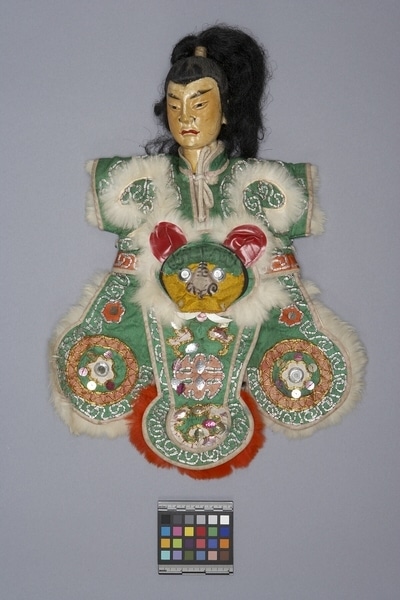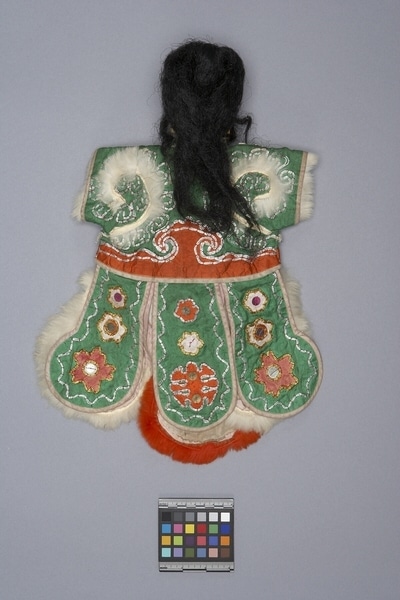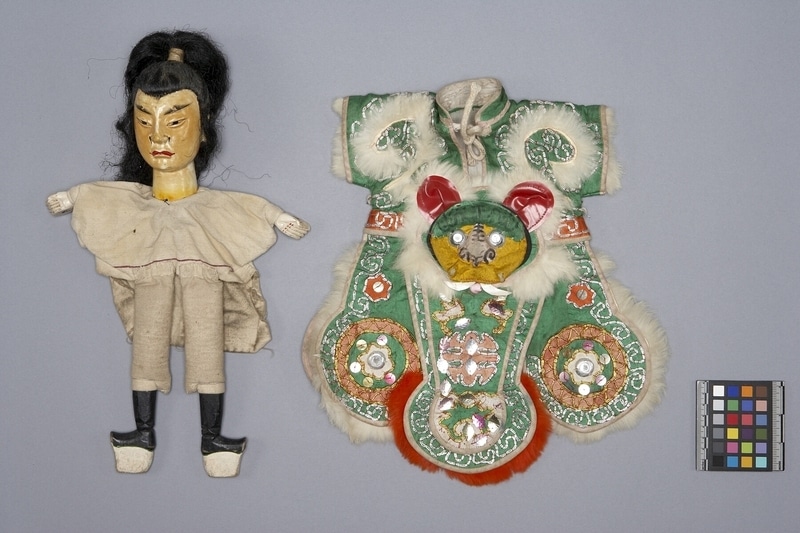Hand Puppet Item Number: Ia58 a-b from the MOA: University of British Columbia



Description
Hand puppet representing the character Wu Sheng (young warrior). Costumed cloth hand puppet with carved, painted wooden head, hands and feet. Varnished yellow/cream face, black and red detail; black hair glued; ponytail held with glued string. Body (part a) is undyed cotton flaps, attaching around head with attached white hands with holes through sideways; stuffed legs with attached white and green soled black boots. Pasted and stitched panelled green silk robe (part b) in six rounded sections; double front flap at centre; cotton lined. Orange waistband and insets; stuffed yellow and green cat face at centre with red plastic ears, tongue and white plastic fangs; metal eyes. Decorations include; silver foil wrapped tread meanders, gold foil wrapped thread outlines, round and leaf shaped metal sequins and white and orange fur trim. Detachable costume; cord tie at neck.
History Of Use
This puppet represents the character Wu Sheng (young warrior). Chinese hand puppet theatre continues to be an active form of popular entertainment in Taiwan. In general, it has a long (over 2,000 years) history which reached a peak of activity during the Qing Dynasty. By then Fukinese hand puppet theatre had reached Taiwan and by 1900, five hundred troupes were touring the island, playing during seasonal festivals, religious celebrations, birthdays, weddings and banquets. Traditionally, 7 men made up a troupe, 2 to manipulate the puppets and speak the roles, and 5 musicians to provide accompaniment and sound effects. Plots are adapted from novels, fairy and folk tales, history and from supernatural events. Short comic scenes opened the presentation, followed by long plays. By 1900, in Taiwan, puppet theatre began taking on distinctive Taiwanese traits, and after the outbreak of the Sino-Japanese War, Fukinese puppets were no longer imported. Puppets became larger (closer to 50 cm) and less finely carved. Costumes are patterned on Ming Dynasty (1368-1644) dress, and the iconographic style often follows Chinese opera.
Cultural Context
Used in puppet theatre performances.
Iconographic Meaning
Puppet; yellow face signifies intelligence or well-distinguished reserves of strength. Fine featured, beardless face suggests a young nobleman. Costume; the green, rounded robe with tiger insignia suggests a warrior's costume. The leaves may be artemisia, a symbol of felicity and healing (Hughes).
Item History
- Made in Taiwan before 1950
- Owned by Dorian Rae before October 31, 1980
- Received from Museum of Anthropology Shop Volunteers (Funding source) and Dorian Rae (Seller) on October 31, 1980
What
- Name
- Hand Puppet
- Identification Number
- Ia58 a-b
- Type of Item
- puppet
- Material
- cotton fibre, wood, paste adhesive, skin, metal, paper, plastic, silk fibre, adhesive, hair, lacquer and paint
- Manufacturing Technique
- carved, painted, glued, stitched, pasted and stuffed
- Overall
- height 47.0 cm, width 34.0 cm, depth 8.8 cm
Who
- Culture
- Taiwanese
- Previous Owner
- Dorian Rae
- Received from
- Museum of Anthropology Shop Volunteers (Funding source) and Dorian Rae (Seller)
Where
- Holding Institution
- MOA: University of British Columbia
- Made in
- Taiwan
When
- Creation Date
- before 1950
- Ownership Date
- before October 31, 1980
- Acquisition Date
- on October 31, 1980
Other
- Condition
- fair
- Accession Number
- 0677/0002